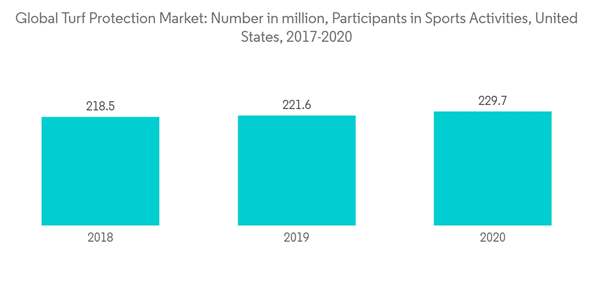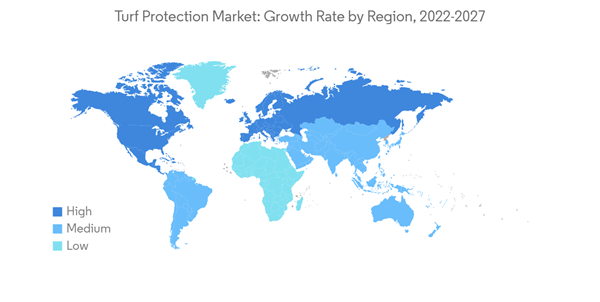The Turf Protection Market size is estimated at USD 6.49 billion in 2024, and is expected to reach USD 8.25 billion by 2029, growing at a CAGR of 4.90% during the forecast period (2024-2029).
The COVID-19 pandemic disrupted the working of several markets, including the turf protection market globally. The pandemic affected the supply chain networks, resulting in losses for companies. In terms of supply, a short-term shortage of migrant laborers amidst distribution bottlenecks created a wide gap between the number of workers required for pesticide production. However, the COVID-19 pandemic had a short-term effect on the market growth but is likely to boost investment. The turf protection industry has been transforming over the years, with robust growth and changing trends.
Maintaining a lawn is a difficult task, and thus it needs turf protection to prevent losses caused by pests and weeds. Increasing high demand for sports like cricket, golf, and football is likely to fuel the market during the forecast period. Companies with high innovation are quickly adapting to the changes and earning a high margin. An increase in both export-oriented and domestic market revenue is observed for major players in the turf protection market. However, challenges such as competition between local players, increasing buyer bargaining power, and competition for good quality supply with low cost are the restraints to the forecast market.
For instance, Germany is famous for its sports activities, more precisely for football, the Bundesliga League, and others for which the stadiums are usually jam-packed. This is encouraging and bringing a high entry of attendees to the stadium, which is likely to boost the market growth over the forecast period.
Adoption of integrated pest management in the turf is likely to add a bonus to the turf protection market. Growing demand for bio-based protections to reduce health hazards and cost-effectiveness are likely to gear up the market.
In 2021, BASF introduced Alucion 35 WG insecticide specifically for the golf course market. This new dual-active, non-restricted use product provides golf course superintendents with a highly effective solution for controlling a wide range of surface-feeding insects. The insecticide protects turf from insect pests, including nuisance ants, chinch bugs, cutworms, and annual bluegrass weevils.
This product will be delivered within 2 business days.
The COVID-19 pandemic disrupted the working of several markets, including the turf protection market globally. The pandemic affected the supply chain networks, resulting in losses for companies. In terms of supply, a short-term shortage of migrant laborers amidst distribution bottlenecks created a wide gap between the number of workers required for pesticide production. However, the COVID-19 pandemic had a short-term effect on the market growth but is likely to boost investment. The turf protection industry has been transforming over the years, with robust growth and changing trends.
Maintaining a lawn is a difficult task, and thus it needs turf protection to prevent losses caused by pests and weeds. Increasing high demand for sports like cricket, golf, and football is likely to fuel the market during the forecast period. Companies with high innovation are quickly adapting to the changes and earning a high margin. An increase in both export-oriented and domestic market revenue is observed for major players in the turf protection market. However, challenges such as competition between local players, increasing buyer bargaining power, and competition for good quality supply with low cost are the restraints to the forecast market.
Turf Protection Market Trends
Expansion of Sports Activities
All of the sports events found host cities globally, indicating increasing parallel demand to stage sporting events of varying sizes depending on the scale, requirements, and objectives. Thus, maintaining turf is essential for commercial sports purposes. Increasing demand for turf for residential and commercial properties, in turn, creates demand for the turf protection market. Thus, driving the growth of the forecast market in the near future. According to the Physical Activity Council, United States, the number of participants increased from 216.9 million in 2017 to 229.7 in 2020. Thus, the turf protection requirements are likely to increase due to the increasing football and golf activities.For instance, Germany is famous for its sports activities, more precisely for football, the Bundesliga League, and others for which the stadiums are usually jam-packed. This is encouraging and bringing a high entry of attendees to the stadium, which is likely to boost the market growth over the forecast period.
Adoption of integrated pest management in the turf is likely to add a bonus to the turf protection market. Growing demand for bio-based protections to reduce health hazards and cost-effectiveness are likely to gear up the market.
North America Dominates the Market
North America dominates the turf protection market in terms of revenue generation as compared to that of markets of other regions. The presence of major players and an increasing number of sports fields in the region are major factors to drive the growth of turf protection. According to the Physical Activity Council, US, the participation rate in sports activities increased to 75.6% in 2020 from 72.7% in 2017. Huge residential regions with plenty of play areas, public parks, and a large number of golf courses are some of the factors that define the extent of the market in the region. The United States occupies the majority of the turf and ornamental chemical inputs market share within the region, followed by Canada. Mexico, due to its harsh climatic conditions, is still in a nascent stage. However, it is expected to grow considerably due to comparatively warmer southern regions.In 2021, BASF introduced Alucion 35 WG insecticide specifically for the golf course market. This new dual-active, non-restricted use product provides golf course superintendents with a highly effective solution for controlling a wide range of surface-feeding insects. The insecticide protects turf from insect pests, including nuisance ants, chinch bugs, cutworms, and annual bluegrass weevils.
Turf Protection Industry Overview
The turf protection market is moderately consolidated, with major players holding a significant share in the market. Bayer CropScience AG, ADAMA Ltd, Syngenta AG, BASF SE, AMVAC Chemical Corporation, and UPL are the major players in the market who are adaptable to quick changes in the market through key industry strategies. The leading companies focused on the expansion of the business across regions and product innovations. To provide insights into the operating companies, business profiles of leading turf protection manufacturers are included in the report.Additional Benefits:
- The market estimate (ME) sheet in Excel format
- 3 months of analyst support
This product will be delivered within 2 business days.
Table of Contents
1 INTRODUCTION
4 MARKET DYNAMICS
5 MARKET SEGMENTATION
6 COMPETITIVE LANDSCAPE
Companies Mentioned (Partial List)
A selection of companies mentioned in this report includes, but is not limited to:
- ADAMA Ltd
- AMVAC Chemical Corporation
- UPL
- BASF SE
- Bayer Cropscience AG
- Nufarm
- Marrone Bio Innovations
- Syngenta AG
- Sumitomo Chemical Australia
Methodology

LOADING...










